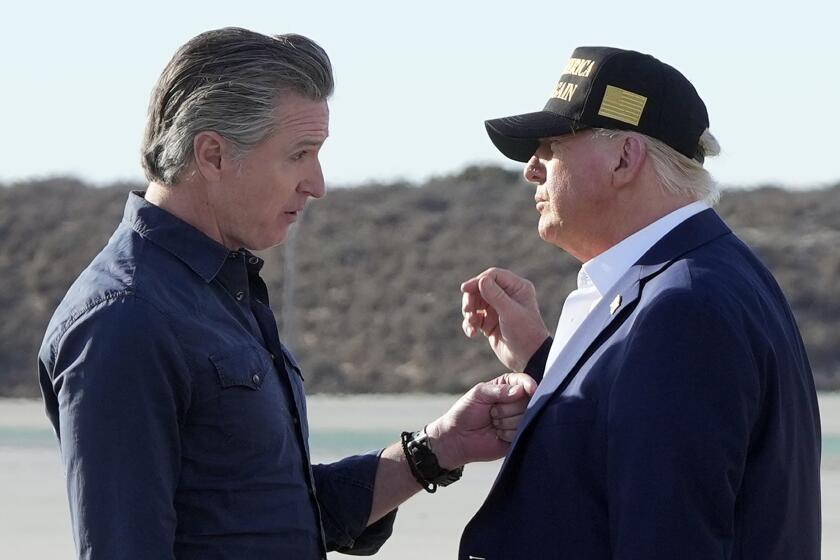Rick Caruso could soon be L.A. mayor. But he’s got no climate plan
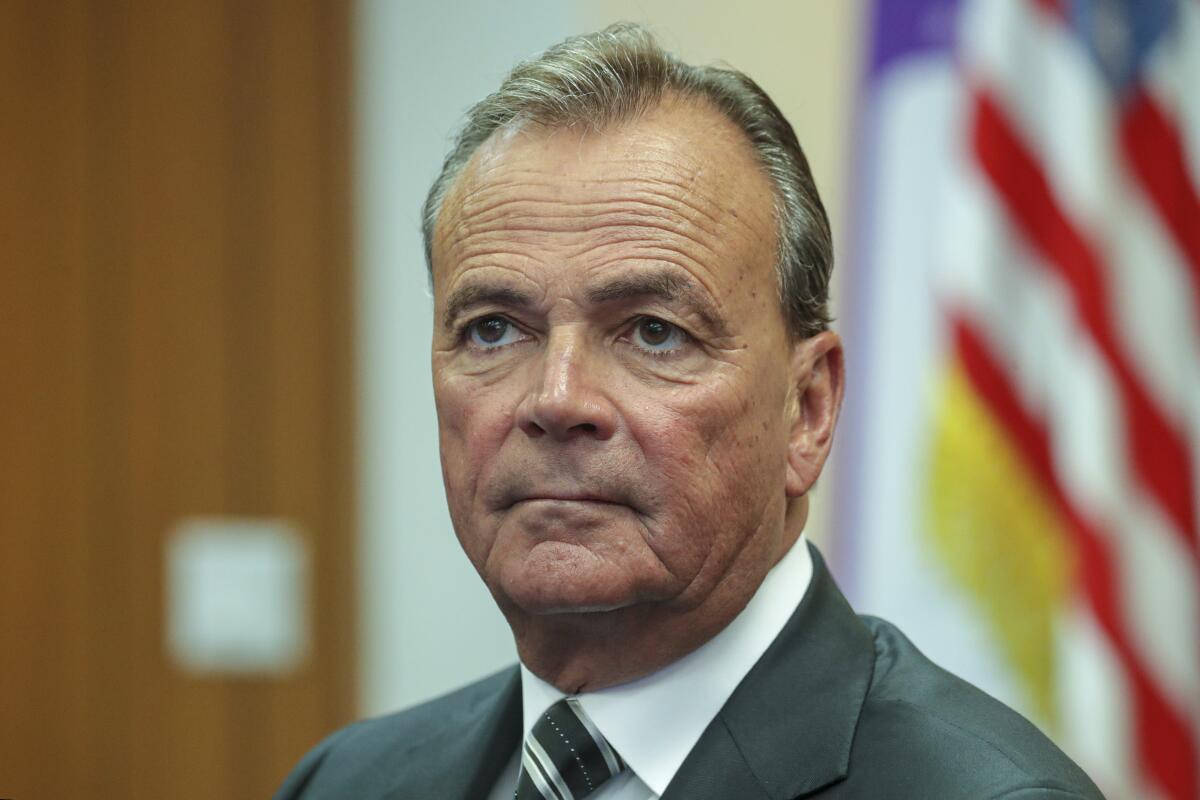
- Share via
This is the May 26, 2022, edition of Boiling Point, a weekly newsletter about climate change and the environment in California and the American West. Sign up here to get it in your inbox.
Many Angelenos have already submitted their ballots ahead of the June 7 primary election. And they’ve cast their votes without knowing much of anything about how the leading candidate for Los Angeles mayor would tackle the climate crisis.
When I wrote last month about where the mayoral candidates stand on climate, billionaire real estate developer Rick Caruso was the only one who wouldn’t talk with me. Instead, his campaign sent a written statement in which he pledged to release a “comprehensive” climate plan “in the coming weeks.” Five weeks later — with 12 days until voting ends — he still hasn’t.
Caruso is dramatically outspending the competition and has held a narrow lead over U.S. Rep. Karen Bass in recent polls (with other candidates, including City Councilmember Kevin de León, polling in the single digits). Although the most likely outcome is Caruso and Bass facing off in a November runoff, there’s a chance Caruso could exceed 50% of the vote, winning outright.
It’s bizarre that Caruso would spend tens of millions of dollars persuading Angelenos to vote for him while largely ignoring one of the most pressing challenges facing the city. As the planet heats up, bigger and more aggressive wildfires are forcing evacuations and blanketing L.A. with choking smoke. Hotter heat waves are killing vulnerable Angelenos, especially the elderly. Climate-fueled drought is forcing unprecedented water restrictions. Rising seas threaten coastal property and beloved beaches.
Yes, an L.A. Times poll found that voters’ top priorities are homelessness, crime and public safety, and affordable housing — which explains why Caruso and other high-profile candidates have focused on those issues. But Angelenos definitely care about climate change and the environment, with 81% of voters describing air pollution and 64% describing extreme heat as serious threats to their health and safety. Our poll found widespread support for more public transit and less water-guzzling ornamental grass.
Bass and De León also haven’t spent much time talking climate. But they’ve both released detailed climate plans (see here and here). And unlike Caruso, they both participated in a debate hosted by the L.A. League of Conservation Voters last month.
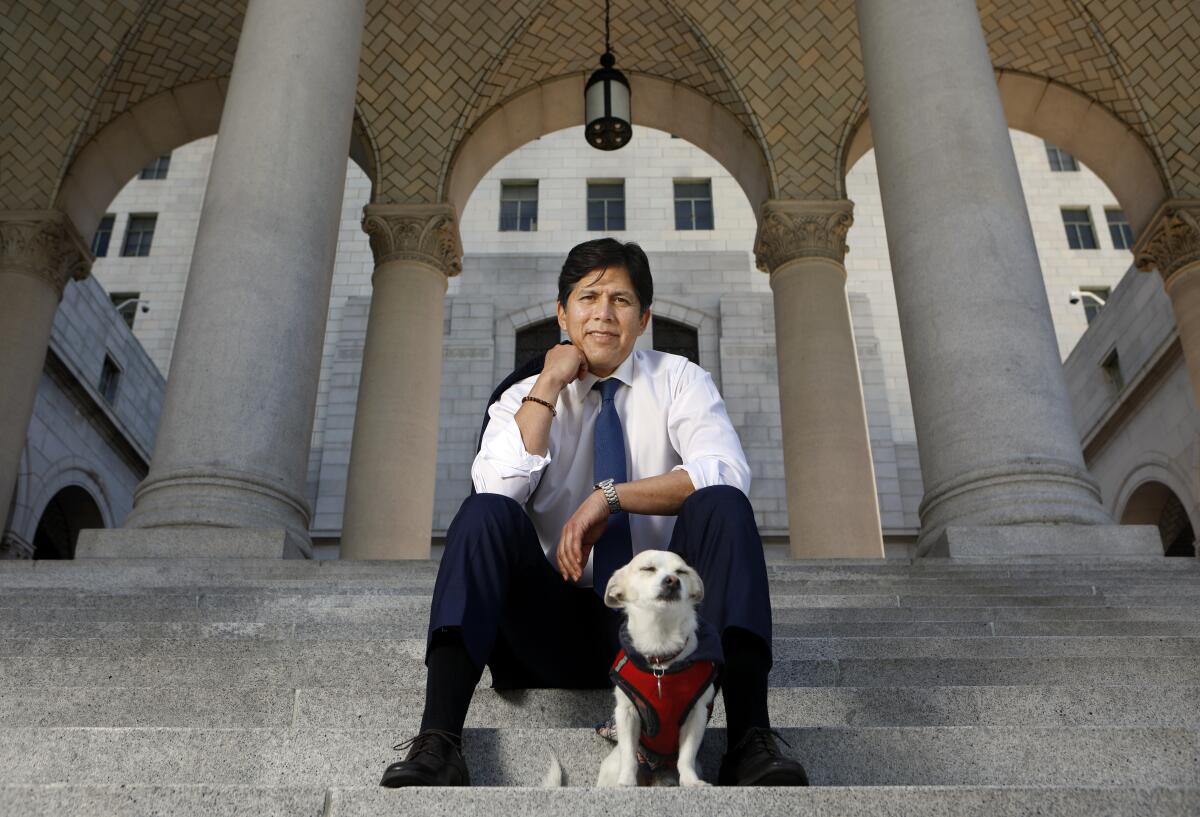
Aura Vasquez, a board member at the conservation group and former L.A. Department of Water and Power commissioner, said she’s frustrated by how little the candidates have emphasized climate — even De León, whom the conservation group endorsed.
But Caruso is in a class by himself. Vasquez said she’s got no idea whom he would appoint to agencies such as DWP and Metro, and how committed he is to climate priorities such as 100% clean energy and planting trees to cool low-income neighborhoods.
“Who are we entrusting our city to?” she asked.
In his written statement last month, Caruso said the social and economic impacts of climate change “will become irreversible if we don’t act with urgency.” That urgency “will be reflected in policies that meaningfully move us away from our overdependence on fossil fuels and prioritize the needs of communities that have suffered the most from environmental injustice,” he said.
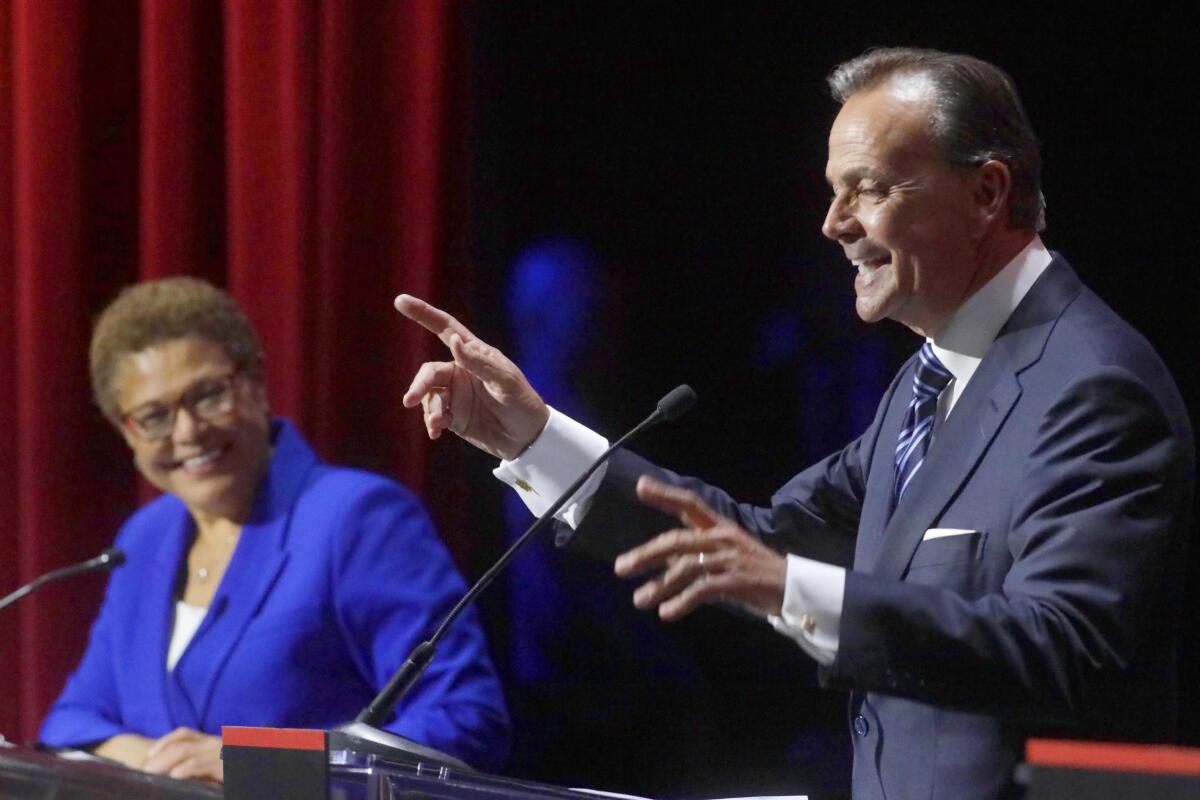
He touted his tenure as president of the Department of Water and Power’s board of commissioners from 1997 to 2000, during which time DWP launched “Green Power for a Green L.A.” to boost renewable energy, supplied efficient lightbulbs to low-income households and approved millions of dollars in incentives for homes to install rooftop solar panels, among other initiatives.
Caruso’s campaign also sent a list of sustainability features at his malls and other properties, including the Palisades Village shopping center, which Caruso called “the first ground-up, mixed-used business district in California that was certified LEED Gold.”
“We must act with bold leadership around sustainability issues and I will do that as Mayor,” he said.
But Caruso hasn’t offered many specifics on the issues I asked the other candidates about, such as shutting down L.A.’s gas-fired power plants, banning gas hookups in new housing, protecting Angelenos from extreme heat and recycling wastewater.
In an Earth Day tweet shortly after my story on the mayoral candidates was published, Caruso said he is “committed to implementing the most aggressive climate and sustainability plan in the nation” — without sharing any details about that plan.
Caruso similarly declined an opportunity to talk with my colleague Rachel Uranga about how he’d improve public transit and reduce traffic congestion — key issues not only for enhancing quality of life but also for slashing planet-warming pollution from cars. A spokesperson told Rachel that Caruso was not “ready” to talk transportation. Other candidates, including Bass and De León, were once again willing to share their ideas, from safer trains to expanded rail in the San Fernando Valley.
For all its shortcomings on climate policy — and there are many — Los Angeles has at least attempted to show leadership. Mayor Eric Garcetti’s target of 100% clean electricity by 2035, a decade ahead of President Biden’s goal for the nation, is one example. So is Measure M, a half-cent sales tax approved by L.A. County voters that is funding a massive expansion of Metro rail lines.
Another significant move could be coming Friday, when L.A. City Council is scheduled to vote on a proposal that would speed the transition to all-electric homes, with no gas furnaces or gas stoves that spew indoor air pollution and fuel the climate crisis.

The motion from Councilmember Nithya Raman would require new buildings to be emissions-free, tasking city officials with crafting the rules. Although the gas industry has promoted green hydrogen and other non-fossil fuels as solutions, the likely outcome is most new homes being built with electric heat pumps for heating and cooling, and induction stoves for cooking.
In an interview earlier this year, Raman framed the push for cleaner homes as part of a broader reimagining of Los Angeles.
“We’re planning for a whole new city,” she told me.
What kind of climate future is Caruso planning for? We still don’t know. A campaign spokesperson didn’t give me an answer when I asked this week about Caruso’s timeline for releasing a climate plan, or when I renewed my request for an interview.
Assuming he survives the primary, Caruso has five more months to tell voters where he stands on climate. I’ll keep you posted.
For now, here’s what’s happening around the West:
TOP STORIES

Former Interior Secretary Bruce Babbitt says it’s time to renegotiate the Colorado River Compact. Babbitt — who also served as Arizona governor — told my colleague Ian James that the century-old pact needs to be revamped to cope with today’s climate realities, in part so that the Lower Basin states of California, Arizona and Nevada share cuts equally with the Upper Basin. Of course, there are other possible solutions on the table. The Land Desk’s Jonathan P. Thompson says it’s time to talk about “demand management” for agriculture — in other words, paying farmers to use less water, or even fallow their fields. Whatever the solutions look like, they’re especially important for places like Tijuana, which is highly dependent on the Colorado and has been suffering more and more water shutoffs, per this piece by Vicente Calderón and MacKenzie Elmer for Voice of San Diego.
In other drought news, California just banned the use of drinking water to irrigate “non-functional” grass at commercial, industrial and institutional properties. Here’s the story from Ian James. Just don’t ask state officials whether non-playing areas at golf courses are covered by the new restrictions; they don’t have much of an answer. Gov. Gavin Newsom, meanwhile, is still requesting but not requiring water conservation from homes. We definitely should all be cutting back, while still taking care of trees, if we’ve got them; The Times’ Jaimie Ding explains how to do that. Using less water to wash dishes is another good idea; here are some tips from Ada Tseng. And if you’ve got a swimming pool, you ought to be using a cover to reduce evaporation, although it doesn’t seem like any Southern California water agencies are requiring this. My colleague Hayley Smith asked them why.
“Why is it that deep blue state like California can’t pass more policies, more bills, to phase out fossil fuels?” One reason seems to be organized labor. As The Times’ Phil Willon reports, a bill that would have limited offshore oil drilling died a quiet death in the Legislature after facing opposition from oil and gas workers. In another example of the fossil fuel industry’s political power, a bill that would have required the Aliso Canyon gas storage field to be shut down by 2027 was gutted this week, per Olga Grigoryants at the L.A. Daily News. “It looks like Sempra got to the bill,” said state Sen. Henry Stern, the bill’s author, referring to the parent company of Aliso Canyon operator Southern California Gas. At the same time, fossil fuel infrastructure faces increasing scrutiny. In Bakersfield, state officials confirmed this week that two idle oil wells were leaking methane gas not far from homes, my colleague Nathan Solis reports — and within a few days, four more leaky wells were found, per the Desert Sun’s Janet Wilson.
THE ENERGY TRANSITION
Drought, heat, fire, coal retirements, supply-chain constraints and more — they’re all adding up to a serious risk of power shortages across the country this summer. Details here from Peter Behr and Jason Plautz at E&E News. Batteries are part of the solution, and not just the lithium-ion kind; Dan Gearino writes for Inside Climate News about a flow battery pilot project taking shape in San Diego County, and Elizabeth McCarthy writes for Utility Dive about the federal government launching a $500-million program to drive down long-duration storage costs. Gov. Gavin Newsom, meanwhile, wants to spend billions shoring up the state’s electricity supplies — and most of it would likely go to gas plants and diesel generators, Jeff St. John reports for Canary Media.
The California National Guard broke ground on a 99-acre solar microgrid at its training base in Los Alamitos, in Orange County. Here’s the story from Daniel Langhorne for The Times. The microgrid includes 26 megawatts of solar power and a 40 megawatt-hour battery. It’s expected to run on climate-friendly power 99% of the time, although it also includes three megawatts of fossil-fueled backup generators in case of emergency, per the military. Some clean energy advocates, meanwhile, continue to argue that California would have an easier time keeping the lights on after dark without fossil fuels by delaying closure of the Diablo Canyon nuclear plant. State officials will have some extra time to decide what to do about Diablo, with the Biden administration extending a deadline to apply for bailout funding, as Rob Nikolewski reports for the San Diego Union-Tribune.
In a new documentary, former Tesla employees open up about what they see as the electric car company’s lax approach to safety under Elon Musk. My colleague Russ Mitchell writes that the documentary was “solidly reported and dead-accurate.” L.A. Times columnist Michael Hiltzik, meanwhile, took a broader look at what he describes as Musk’s history of breaking the law, and the tendency of state and federal regulators to let him get away with it. It’s worth pointing out that while electric vehicles are absolutely crucial for addressing climate change, they’re not the only alternative to oil-based transportation. The Times’ Jonah Valdez talked with cyclists about how they get around Los Angeles car-free. And South L.A. residents will soon be eligible for $150 per month in transit funds as part of a pilot program funded by the state. Details here from Jonah, Jon Healey and Rachel Uranga.
POLITICAL CLIMATE
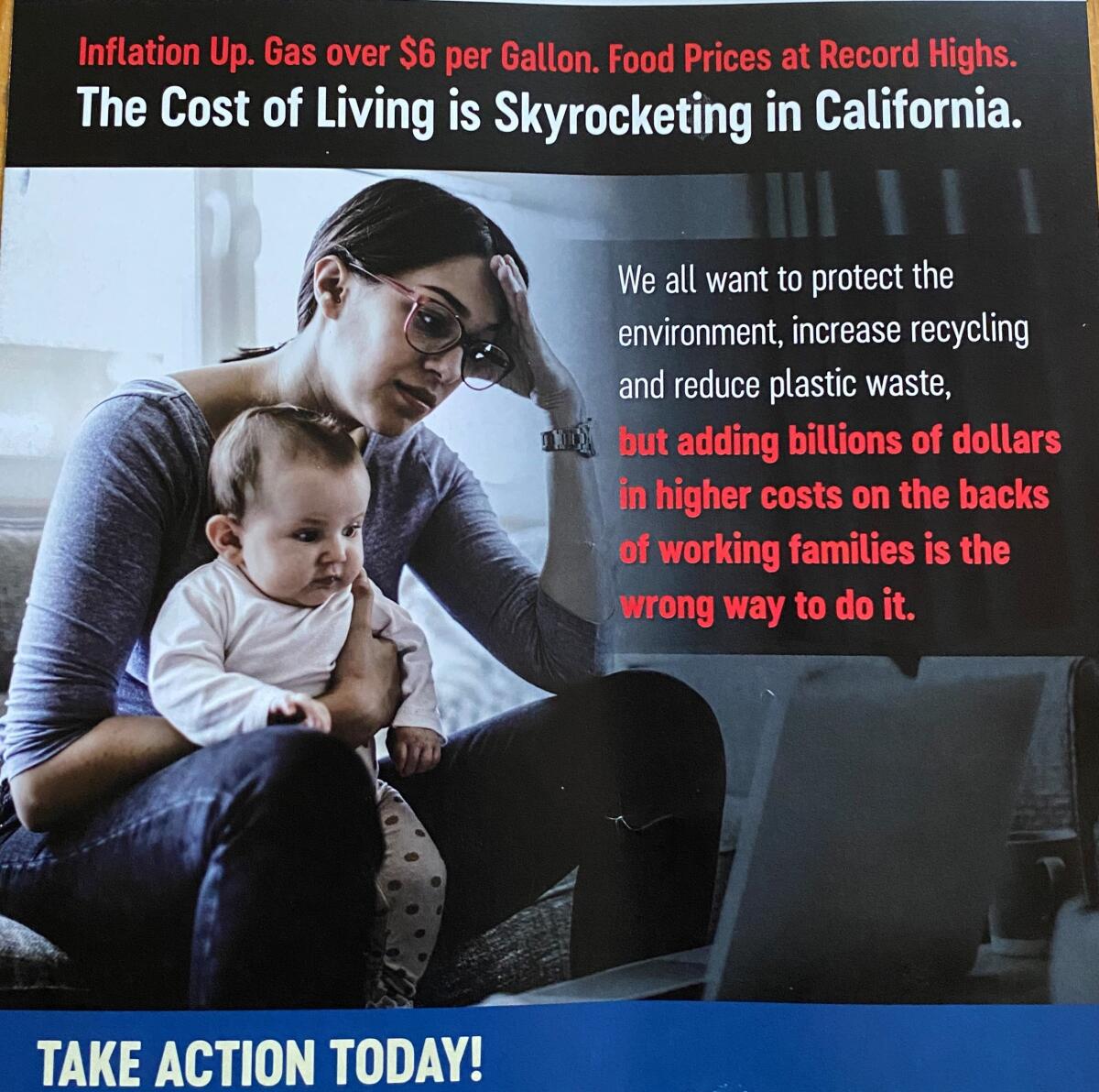
The plastics industry is sending out fliers targeting Democratic lawmakers in Southern California, warning against “billions of dollars in higher costs on the backs of working families.” The thing is, the ballot measure the industry is worried about — which would restrict single-use plastic packaging — explicitly says compliance costs cannot be passed on to consumers, my colleague Susanne Rust reports. The plastics industry’s messaging, which critics see as deceptive, may be designed to pressure lawmakers into passing watered-down legislation that would derail the ballot measure and be more acceptable to the industry.
Two California lawmakers want Merrick Garland, the U.S. attorney general, to investigate water privatization in the West as hedge funds buy up water rights. “The domino effect of this activity consolidates economic power and water itself in the hands of the few and will likely require the ‘big stick’ of antitrust actions to break up, lest average Americans are brought to their knees for lack of the most basic resource, water,” state Sens. Melissa Hurtado and Dave Cortese wrote, per Charles Whisnand at the Porterville Recorder. At the same time, public stewardship doesn’t solve all water problems. Just read this investigation from Oregon Public Broadcasting and ProPublica, finding the federal government is doing a poor job managing salmon hatcheries to increase fish survival rates in the Pacific Northwest. There are similar problems in California, where The Times’ Christian Martinez reports that officials are trucking Chinook salmon to cooler waters in hopes of avoiding another disastrous spawning season.
“It is a walk back in time to a gentle valley. It is one of those places where people will visit and say, ‘Oh, my goodness, this is where I live.’” So says the director of California’s parks department, describing Dos Rios Ranch, the newest state park in more than a decade. Gov. Gavin Newsom’s budget proposal includes $5 million for the park at the confluence of the Tuolumne and San Joaquin rivers near Modesto, as Parth M.N. reports for The Times. Public access is expected to begin in 2023, state officials say.
AROUND THE WEST
The U.S. Forest Service will stop conducting prescribed burns until this fall at the earliest, with the agency’s chief, Randy Moore, saying increasingly hot, dry conditions have made them too dangerous. It’s an ironic decision, considering that prescribed burns are meant to prevent even worse fires by depriving the landscape of excess fuel, as Susan Montoya Bryan reports for the Associated Press. In another bitter irony, the gargantuan fire burning in New Mexico is threatening a seed bank that stores millions of ponderosa pine, spruce and other conifer seeds used to help replant and restore forests post-wildfire; here’s Susan Montoya Bryan again. Keeping trees alive also keeps carbon out of the atmosphere, which helps explain why President Biden issued an executive order last month to protect old-growth forests from logging and other threats. But what counts as “old growth”? The federal government doesn’t yet have an answer, Matthew Brown and Matthew Daly report for the Associated Press.
In California, Pacific Gas & Electric’s effort to bury 10,000 miles of power lines — and thus prevent those lines from igniting fires — is underway. The company is starting with 175 miles this year, at a cost of $3.75 million per mile. Here’s what it looks like in Walnut Creek, via Lisa M. Krieger at the Mercury News. Farther south, my colleague Diana Marcum has a snapshot of post-wildfire life in the Sierra Nevada; farther west, a man was sentenced to 24 years in prison for setting the Big Sur fire that killed 12 endangered condors, Nathan Solis reports. And before we move on from fires, one last story: The Arizona Republic’s Joan Meiners has a fascinating piece on why climate change could stop forests from regenerating after wildfires as they have in the past.
New research finds that Environmental Protection Agency data dramatically underestimate air pollution in parts of the Bay Area where people of color and low-income families live. Here’s the story from the Washington Post’s Darryl Fears, who writes that a tech company measured the region’s air quality block by block, providing a more complete view than EPA’s stationary air monitors. The company found that communities of color are exposed to 55% more smog-forming nitrogen dioxide pollution than white communities. Additionally, “poor people of all ethnicities experience a 30% higher exposure to nitrogen dioxide compared to wealthier residents, and concentrations can vary up to 800% from one end of a block to the next,” Fears writes.
ONE MORE THING

If you’ve been reading this newsletter the last few weeks, then you know about the “Repowering the West” reporting project that the L.A. Times launched this month, starting with my energy road trip across Wyoming, Utah, Colorado and Nevada.
I’ll be busy writing a deeper story about the trip the next few weeks, so some of my colleagues will fill in on Boiling Point. Please give them a warm welcome! And in the meantime, feel free to watch this recent segment of L.A. Times Today, in which I talked with anchor Lisa McRee about Repowering the West. The TV program airs weeknights on Spectrum News 1 at 7 p.m. and 10 p.m.
We’ll be back in your inbox next week. If you enjoyed this newsletter, please consider forwarding it to your friends and colleagues.




